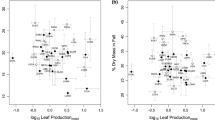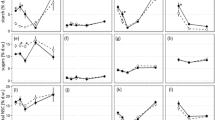Abstract
Fruiting is typically considered to massively burden the seasonal carbon budget of trees. The cost of reproduction has therefore been suggested as a proximate factor explaining observed mast-fruiting patterns. Here, we used a large-scale, continuous 13C labeling of mature, deciduous trees in a temperate Swiss forest to investigate to what extent fruit formation in three species with masting reproduction behavior (Carpinus betulus, Fagus sylvatica, Quercus petraea) relies on the import of stored carbon reserves. Using a free-air CO2 enrichment system, we exposed trees to 13C-depleted CO2 during 8 consecutive years. By the end of this experiment, carbon reserve pools had significantly lower δ13C values compared to control trees. δ13C analysis of new biomass during the first season after termination of the CO2 enrichment allowed us to distinguish the sources of built-in carbon (old carbon reserves vs. current assimilates). Flowers and expanding leaves carried a significant 13C label from old carbon stores. In contrast, fruits and vegetative infructescence tissues were exclusively produced from current, unlabeled photoassimilates in all three species, including F. sylvatica, which had a strong masting season. Analyses of δ13C in purified starch from xylem of fruit-bearing shoots revealed a complete turn-over of starch during the season, likely due to its usage for bud break. This study is the first to directly demonstrate that fruiting is independent from old carbon reserves in masting trees, with significant implications for mechanistic models that explain mast seeding.





Similar content being viewed by others
References
Aschan G, Pfanz H (2003) Non-foliar photosynthesis—a strategy of additional carbon acquisition. Flora 198:81–97
Bell G (1980) The costs of reproduction and their consequences. Am Nat 116:45–75
Bustan A, Avni A, Lavee S, Zipori I, Yeselson Y, Schaffer AA, Riov J, Dag A (2011) Role of carbohydrate reserves in yield production of intensively cultivated oil olive (Olea europaea L.) trees. Tree Physiol 31:519–530
Crone EE, Miller E, Sala A (2009) How do plants know when other plants are flowering? Resource depletion, pollen limitation and mast-seeding in a perennial wildflower. Ecol Lett 12:1119–1126
Eschrich W, Burchardt R, Essiamah S (1989) The induction of sun and shade leaves of the European beech (Fagus sylvatica L.): anatomical studies. Trees Struct Funct 3:1–10
Genet H, Breda N, Dufrene E (2010) Age-related variation in carbon allocation at tree and stand scales in beech (Fagus sylvatica L.) and sessile oak (Quercus petraea (Matt.) Liebl.) using a chronosequence approach. Tree Physiol 30:177–192
Han Q, Kabeya D, Iio A, Kakubari Y (2008) Masting in Fagus crenata and its influence on the nitrogen content and dry mass of winter buds. Tree Physiol 28:1269–1276
Han Q, Kabeya D, Hoch G (2011) Leaf traits, shoot growth and seed production in mature Fagus sylvatica trees after 8 years of CO2 enrichment. Ann Bot 107:1405–1411
Hasegawa S, Koba K, Tayasu I, Takeda H, Haga H (2003) Carbon autonomy of reproductive shoots of Siberian alder (Alnus hirsuta var. sibirica). J Plant Res 116:183–188
Hoch G (2005) Fruit-bearing branchlets are carbon autonomous in mature broad-leaved temperate forest trees. Plant Cell Environ 28:651–659
Hoch G, Keel SG (2006) 13C labelling reveals different contributions of photoassimilates from infructescences for fruiting in two temperate forest tree species. Plant Biol 8:606–614
Hoch G, Popp M, Körner C (2002) Altitudinal increase of mobile carbon pools in Pinus cembra suggests sink limitation of growth at the Swiss treeline. Oikos 98:361–374
Ichie T, Nakagawa M (2012) Dynamics of mineral nutrient storage for mast reproduction in the tropical emergent tree Dryopalanapos aromatica. Ecol Res (in press)
Isagi Y, Sugimura K, Sumida A, Ito H (1997) How does masting happen and synchronize? J Theor Biol 187:231–239
Jäggi M, Saurer M, Fuhrer J, Siegwolf R (2002) The relationship between the stable carbon isotope composition of needle bulk material, starch, and tree rings in Picea abies. Oecologia 131:325–332
Keel SG, Schädel C (2010) Expanding leaves of mature deciduous forest trees rapidly become autotrophic. Tree Physiol 30:1253–1259
Keel SG, Siegwolf RTW, Körner C (2006) Canopy CO2 enrichment permits tracing the fate of recently assimilated carbon in a mature deciduous forest. New Phytol 172:319–329
Kelly D (1994) The evolutionary ecology of mast seeding. Trends Ecol Evol 9:465–470
Kelly D, Sork VL (2002) Mast seeding in perennial plants: why, how, where? Annu Rev Ecol Syst 33:427–447
Kimura K, Ishida A, Uemura A, Matsumoto Y, Terashima I (1998) Effects of current-year and previous-year PPFDs on shoot gross morphology and leaf properties in Fagus japonica. Tree Physiol 18:459–466
Koenig WD, Knops JMH (2000) Patterns of annual seed production by northern hemisphere trees: a global perspective. Am Nat 155:59–69
Kon H, Noda T, Terazawa K, Koyama H, Yasaka M (2005a) Evolutionary advantages of mast seeding in Fagus crenata. J Ecol 93:1148–1155
Kon H, Noda T, Terazawa K, Koyarna H, Yasaka M (2005b) Proximate factors causing mast seeding in Fagus crenata: the effects of resource level and weather cues. Can J Bot 83:1402–1409
Körner C (2003) Carbon limitation in trees. J Ecol 91:4–17
Körner C et al (2005) Carbon flux and growth in mature deciduous forest trees exposed to elevated CO2. Science 309:1360–1362
Kozlowski TT, Pallardy SG (1997) Physiology of woody plants, 2nd edn. Academic, San Diego
Kozlowski TT, Davis WJ, Pallardy SG (1991) The physiological ecology of woody plants. Academic, San Diego
Lamontagne JM, Boutin S (2007) Local-scale synchrony and variability in mast seed production patterns of Picea glauca. J Ecol 95:991–1000
Landhäusser SM (2011) Aspen shoots are carbon autonomous during bud break. Trees 25:531–536
Miyazaki Y (2013) Dynamics of internal carbon resources during masting behavior in trees. Ecol Res, doi:10.1007/s1284-011-0892-6
Miyazaki Y, Hiura T, Kato E, Funada R (2002) Allocation of resources to reproduction in Styrax obassia in a masting year. Ann Bot 89:767–772
Miyazaki Y, Hiura T, Funada R (2007) Allocation of photoassimilated 13C from reproductive and non-reproductive shoots to fruits in Styrax obassia. Plant Spec Biol 22:53–57
Mund M, Kutsch WL, Wirth C, Kahl T, Knohl A, Skomarkova MV, Schulze E-D (2010) The influence of climate and fructification on the inter-annual variability of stem growth and net primary productivity in an old-growth, mixed beech forest. Tree Physiol 30:689–704
Obeso JR (1998) Effects of defoliation and girdling on fruit production in Ilex aquifolium. Funct Ecol 12:486–491
Obeso JR (2002) The costs of reproduction in plants. New Phytol 155:321–348
Pepin S, Körner C (2002) Web-FACE: a new canopy free air CO2 enrichment system for tall forest trees in mature forests. Oecologia 133:1–9
Sala A, Hopping K, McIntire EJB, Delzon S, Crone EE (2012) Masting in whitebark pine (Pinus albicaulis) depletes stored nutrients. New Phytol 196:189–199
Schädel C, Blöchl A, Richter A, Hoch G (2009) Short-term dynamics of nonstructural carbohydrates and hemicelluloses in young branches of temperate forest trees during bud break. Tree Physiol 29:901–911
Schauber EM, Kelly D, Turchin P, Simon C, Lee WG, Allen RB, Payton IJ, Wilson PR, Cowan PE, Brockie RE (2002) Masting by eighteen New Zealand plant species: the role of temperature as a synchronizing cue. Ecology 83:1214–1225
Shibata M, Tanaka H, Nakashizuka T (1998) Causes and consequences of mast seed production of four co-occurring Carpinus species in Japan. Ecology 79:54–64
Silvertown JW (1980) The evolutionary ecology of mast seeding in trees. Biol J Linn Soc 14:235–250
Smaill SJ, Clinton PW, Allen RB, Davis MR (2011) Climate cues and resources interact to determine seed production by a masting species. J Ecol 99:870–877
Tachiki Y, Iwasa Y, Satake A (2010) Pollinator coupling can induce synchronized flowering in different plant species. J Theor Biol 267:153–163
Volpe G, Bianco LB, Rieger M (2008) Carbon autonomy of peach shoots determined by 13C-photoassimilate transport. Tree Physiol 28:1805–1812
Watson MA (1986) Integrated physiological units in plants. Trends Ecol Evol 1:119–123
Wilson R, Cataldo A, Andersen CP (1995) Determination of total nonstructural carbohydrates in tree species by high-performance anion-exchange chromatography with pulsed amperometric detection. Can J For Res 25:2022–2028
Wong S-C (1990) Elevated atmospheric partial pressure of CO2 and plant growth. II. Non-structural carbohydrate content in cotton plants and its effect on growth parameters. Photosynth Res 23:171–180
Yasumura Y, Hikosaka K, Hirose T (2006) Resource allocation to vegetative and reproductive growth in relation to mast seeding in Fagus crenata. For Ecol Manag 229:228–233
Acknowledgments
The authors would like to thank Catharina Lötscher for starch extraction and 13C analyses, Erwin Amstutz for operating the crane, Daisuke Kabeya for helping in the field and his valuable discussions on tree reproduction, and Olivier Bignucolo, Susanna Riedl and Gabrielle Schaer for litter trap collection and fruit biomass analyses. We further thank the two anonymous referees for their valuable comments and their helpful suggestions to improve the text. This study was partially supported by grants from the Japanese Society for the Promotion of Science (No. 18580155, No. 21380103 to Q.H.) and a research fellowship to Q.H. from the Co-operative OECD Research Program. The CO2 enrichment and crane infrastructure at the SCC site were funded by grants to C.K. from the Swiss National Science Foundation (SNF, No. 3100-059769.99, No. 3100-067775.02) and NCCR-Climate (No. 5005-65755). During the time of writing this manuscript, G.H. received funding from European Research Council (ERC) grant No. 233399 (project ‘TREELIM’ to C.K.).
Author information
Authors and Affiliations
Corresponding author
Additional information
Communicated by Russell Monson.
Rights and permissions
About this article
Cite this article
Hoch, G., Siegwolf, R.T.W., Keel, S.G. et al. Fruit production in three masting tree species does not rely on stored carbon reserves. Oecologia 171, 653–662 (2013). https://doi.org/10.1007/s00442-012-2579-2
Received:
Accepted:
Published:
Issue Date:
DOI: https://doi.org/10.1007/s00442-012-2579-2
Keywords
Profiles
- Sonja G. Keel View author profile




